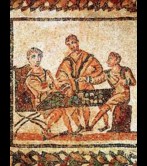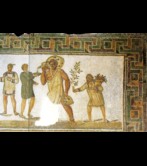The Roman presence
Rome in Gipuzkoa
With Rome, Gipuzkoa enters protohistoria, that is, it is mentioned in foreign texts. Rereading classical Greco-Roman texts in the context of recently discovered archaeological remains gives us a clear idea of who lived in the region and how they lived. The Romans did not systematically colonize the region, far from it, given that the empire had no special interest in it, apart from a few specific points, but their culture left an indelible mark. In fact, the influence began earlier, coming from neighbouring territories, given that Pompaelo was founded in 76 BC and the important Asturica-Burdigala (Astorga-Burdeos) land route passed through the Alavés Llanada and the Navarra Burunda. Coins found in Ataun are testament to this.
Oiasso was without doubt the important Roman centre in Gipuzkoa. Situated in the Bidasoa estuary, the port was protected from the pounding sea and was the point in the Atlantic closest to the Mediterranean to which it was joined by the Oiasso-Tarraco land route. After the conquest of Britain and Germany it acquired greater importance because of the increasing Atlantic sea traffic.
Further information here: "The Roman era" (Bertan Collection).
Fall and legacy
The decline of Oiasso towards the end of the Second and Third centuries didn’t mean that Roman influence in Gipuzkoa disappeared, only that activity moved to other urban areas, although of less importance than Oiasso. Third and Fourth century remains have been found at other points along the coast such as San Sebastian, Zarautz and Getaria, and in the interior such as the salt mine at Leintz Gatzaga, the postures in Urbia, linked to the Alavés Llanada. Judging by these remains, which are cruder, there was a decline in commerce and a tendency toward self-sufficiency, including the reutilization of caves. Lines of communication, especially along the coast, were broken or fell into disuse.
But Roman cultural legacy is immense, in construction techniques, mining, metalworking and in the agriculture that remains today (vines, cereals, figs, plums), in the calendar, numerous games and customs, in the Basque language, which has adopted many words from Latin, and particularly in the new religion, Christianity, which spread from Rome.
Zarautz: space continued to be used




